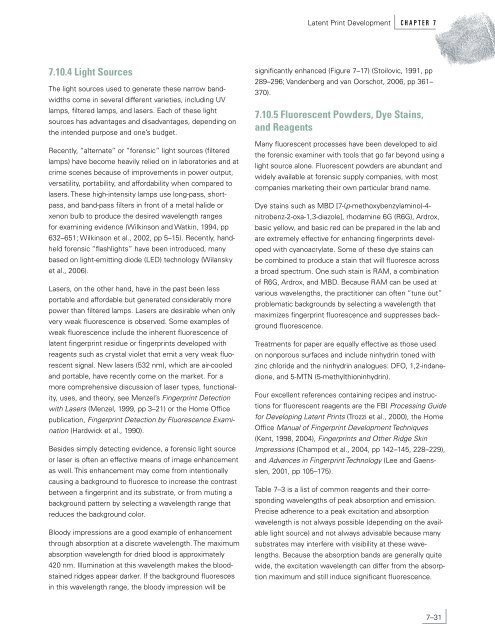Latent Print Development - National Criminal Justice Reference ...
Latent Print Development - National Criminal Justice Reference ...
Latent Print Development - National Criminal Justice Reference ...
You also want an ePaper? Increase the reach of your titles
YUMPU automatically turns print PDFs into web optimized ePapers that Google loves.
7.10.4 Light Sources<br />
The light sources used to generate these narrow band-<br />
widths come in several different varieties, including UV<br />
lamps, filtered lamps, and lasers. Each of these light<br />
sources has advantages and disadvantages, depending on<br />
the intended purpose and one’s budget.<br />
Recently, “alternate” or “forensic” light sources (filtered<br />
lamps) have become heavily relied on in laboratories and at<br />
crime scenes because of improvements in power output,<br />
versatility, portability, and affordability when compared to<br />
lasers. These high-intensity lamps use long-pass, short-<br />
pass, and band-pass filters in front of a metal halide or<br />
xenon bulb to produce the desired wavelength ranges<br />
for examining evidence (Wilkinson and Watkin, 1994, pp<br />
632–651; Wilkinson et al., 2002, pp 5–15). Recently, hand-<br />
held forensic “flashlights” have been introduced, many<br />
based on light-emitting diode (LED) technology (Wilansky<br />
et al., 2006).<br />
Lasers, on the other hand, have in the past been less<br />
portable and affordable but generated considerably more<br />
power than filtered lamps. Lasers are desirable when only<br />
very weak fluorescence is observed. Some examples of<br />
weak fluorescence include the inherent fluorescence of<br />
latent fingerprint residue or fingerprints developed with<br />
reagents such as crystal violet that emit a very weak fluo-<br />
rescent signal. New lasers (532 nm), which are air-cooled<br />
and portable, have recently come on the market. For a<br />
more comprehensive discussion of laser types, functional-<br />
ity, uses, and theory, see Menzel’s Fingerprint Detection<br />
with Lasers (Menzel, 1999, pp 3–21) or the Home Office<br />
publication, Fingerprint Detection by Fluorescence Exami-<br />
nation (Hardwick et al., 1990).<br />
Besides simply detecting evidence, a forensic light source<br />
or laser is often an effective means of image enhancement<br />
as well. This enhancement may come from intentionally<br />
causing a background to fluoresce to increase the contrast<br />
between a fingerprint and its substrate, or from muting a<br />
background pattern by selecting a wavelength range that<br />
reduces the background color.<br />
Bloody impressions are a good example of enhancement<br />
through absorption at a discrete wavelength. The maximum<br />
absorption wavelength for dried blood is approximately<br />
420 nm. Illumination at this wavelength makes the blood-<br />
stained ridges appear darker. If the background fluoresces<br />
in this wavelength range, the bloody impression will be<br />
significantly enhanced (Figure 7–17) (Stoilovic, 1991, pp<br />
289–296; Vandenberg and van Oorschot, 2006, pp 361–<br />
370).<br />
7.10.5 Fluorescent Powders, Dye Stains,<br />
and Reagents<br />
Many fluorescent processes have been developed to aid<br />
the forensic examiner with tools that go far beyond using a<br />
light source alone. Fluorescent powders are abundant and<br />
widely available at forensic supply companies, with most<br />
companies marketing their own particular brand name.<br />
Dye stains such as MBD [7-(p-methoxybenzylamino)-4-<br />
nitrobenz-2-oxa-1,3-diazole], rhodamine 6G (R6G), Ardrox,<br />
basic yellow, and basic red can be prepared in the lab and<br />
are extremely effective for enhancing fingerprints devel-<br />
oped with cyanoacrylate. Some of these dye stains can<br />
be combined to produce a stain that will fluoresce across<br />
a broad spectrum. One such stain is RAM, a combination<br />
of R6G, Ardrox, and MBD. Because RAM can be used at<br />
various wavelengths, the practitioner can often “tune out”<br />
problematic backgrounds by selecting a wavelength that<br />
maximizes fingerprint fluorescence and suppresses back-<br />
ground fluorescence.<br />
Treatments for paper are equally effective as those used<br />
on nonporous surfaces and include ninhydrin toned with<br />
zinc chloride and the ninhydrin analogues: DFO, 1,2-indane-<br />
dione, and 5-MTN (5-methylthioninhydrin).<br />
Four excellent references containing recipes and instruc-<br />
tions for fluorescent reagents are the FBI Processing Guide<br />
for Developing <strong>Latent</strong> <strong>Print</strong>s (Trozzi et al., 2000), the Home<br />
Office Manual of Fingerprint <strong>Development</strong> Techniques<br />
(Kent, 1998, 2004), Fingerprints and Other Ridge Skin<br />
Impressions (Champod et al., 2004, pp 142–145, 228–229),<br />
and Advances in Fingerprint Technology (Lee and Gaens-<br />
slen, 2001, pp 105–175).<br />
<strong>Latent</strong> <strong>Print</strong> <strong>Development</strong> C H A P T E R 7<br />
Table 7–3 is a list of common reagents and their corre-<br />
sponding wavelengths of peak absorption and emission.<br />
Precise adherence to a peak excitation and absorption<br />
wavelength is not always possible (depending on the avail-<br />
able light source) and not always advisable because many<br />
substrates may interfere with visibility at these wave-<br />
lengths. Because the absorption bands are generally quite<br />
wide, the excitation wavelength can differ from the absorp-<br />
tion maximum and still induce significant fluorescence.<br />
7–31

















